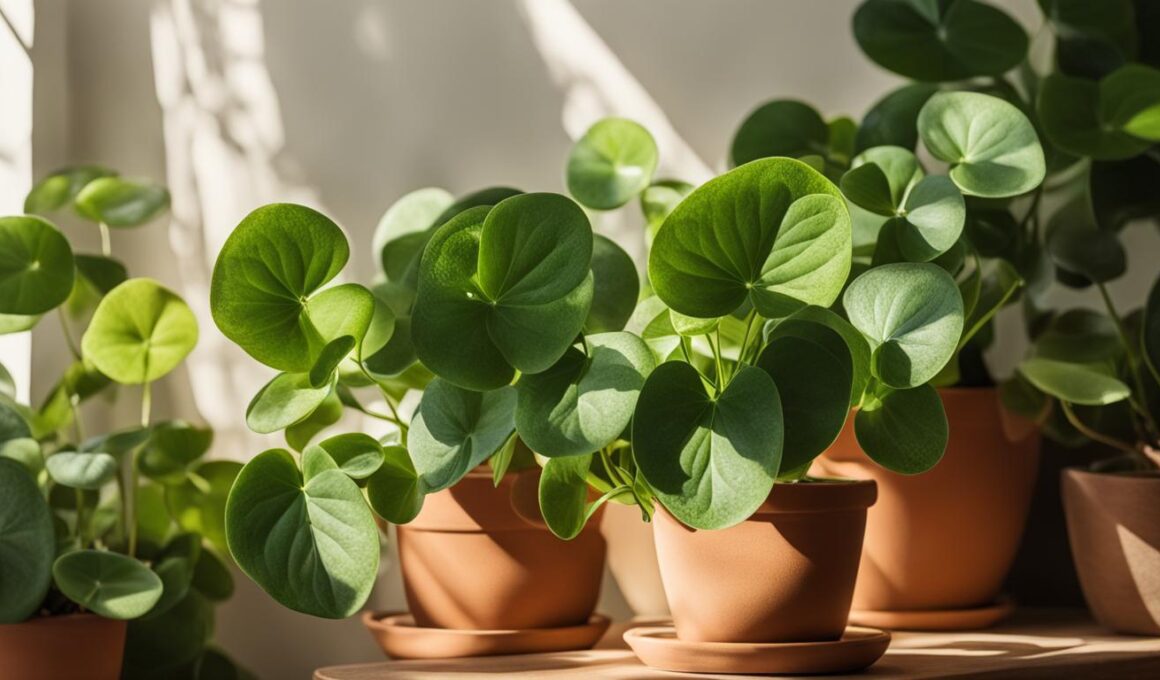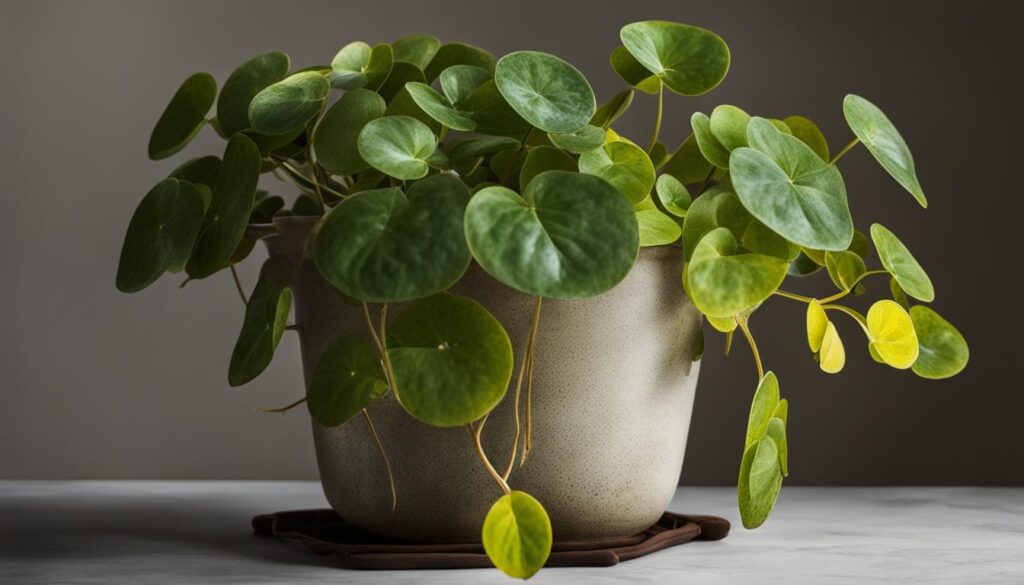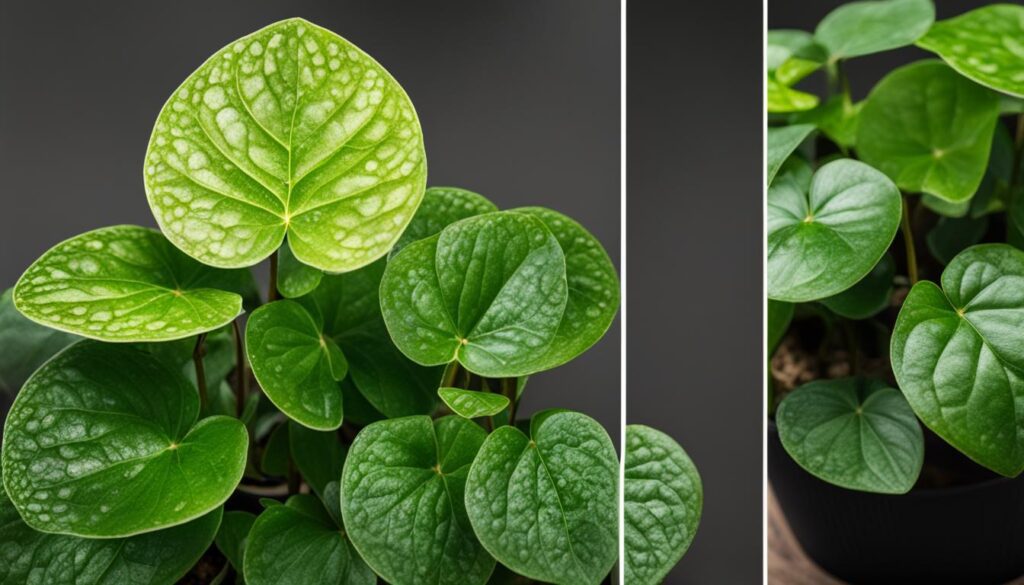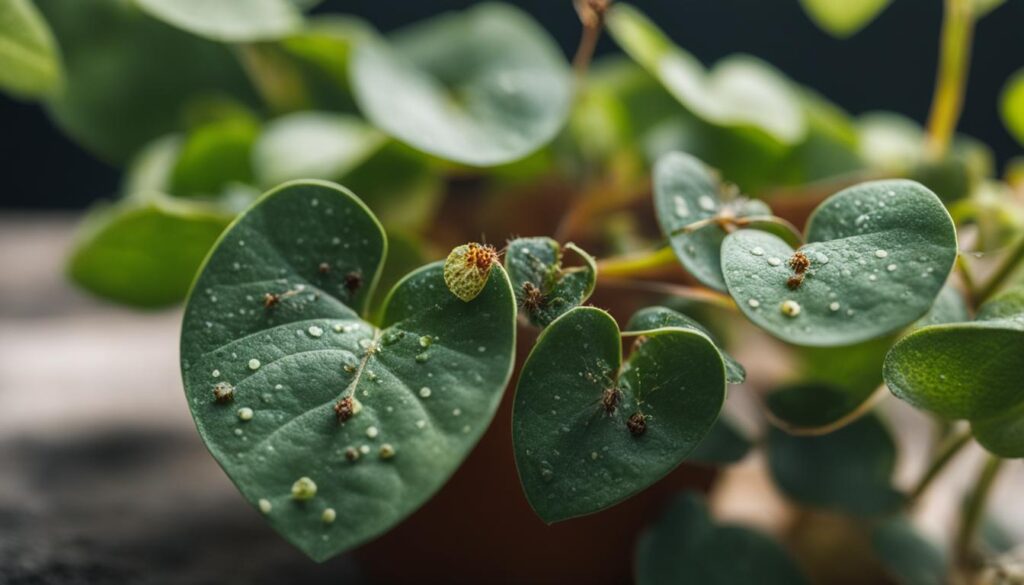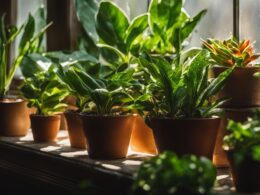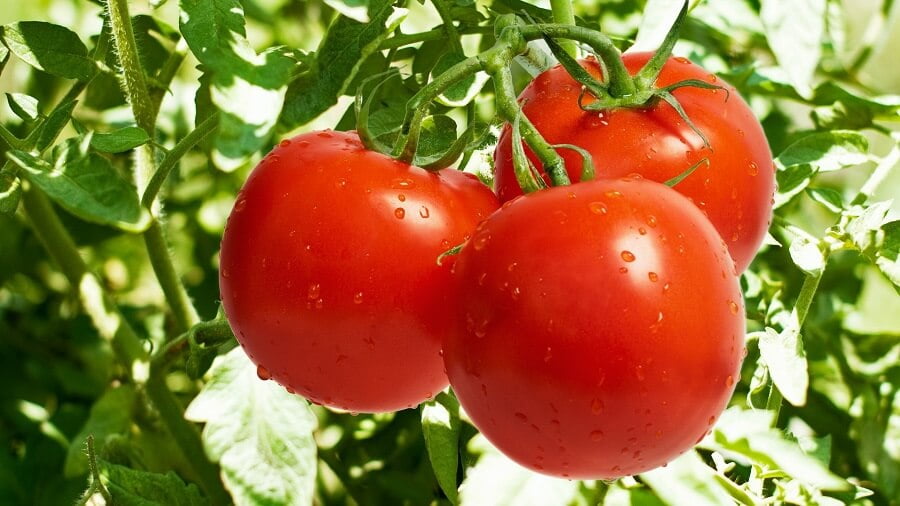Are you struggling to maintain a healthy Chinese Money Plant? Don’t worry; you’re not alone. Many indoor gardeners encounter common Pilea problems, but with the right approach and solutions, you can overcome these challenges and achieve Pilea Peperomioides care success. In this guide, we’ll delve into the secrets behind nurturing your Pilea Peperomioides, addressing issues such as overwatering, nutrient deficiencies, and pest infestations. By understanding and resolving these problems, you’ll be well on your way to growing a thriving, vibrant Chinese Money Plant.
Key Takeaways
- Recognize common Pilea problems and implement effective Pilea Peperomioides solutions
- Master overwatering prevention and management techniques
- Identify and address nutrient deficiencies in your Chinese Money Plant
- Tackle pest infestations using proven control methods, such as Neem Oil and insect-killing soap
- Learn from your Pilea Peperomioides’ leaves, interpreting signs of stress and implementing appropriate care
- Establish a healthy care routine for watering, lighting, humidity, and fertilization to ensure indoor gardening success
- Embrace preventive measures and regular maintenance to cultivate a lush, healthy Pilea Peperomioides
Decoding the Signs: What Your Pilea Peperomioides’ Leaves Are Telling You
The leaves of Pilea Peperomioides communicate its health status, making it possible for you to address potential problems before they escalate. By learning to recognize the signs, you can take adequate measures to nurture your plant back to health. This section will discuss some common Pilea Peperomioides leaf problems you might encounter and their possible causes, helping you decode what your plant’s leaves are telling you.
- Curling Leaves: When you notice curling leaves, it might indicate moisture issues, such as underwatering or lack of humidity. In some cases, the problem can be the exact opposite – overwatering. Both situations lead to similar outcomes, where water uptake and transpiration are not balanced.
- Yellowing Foliage: Yellowing leaves can result from a lack of nutrients or moisture problems. If your Pilea is experiencing this issue, it may need fresh soil or a proper fertilization routine.
- Brown Spots: Brown spots on Pilea leaves are often caused by too much direct sunlight or heat exposure. Keeping the plant in a location with bright, indirect light can help address this issue.
- Dark Brown or Black Patches: These spots may signal overwatering and can lead to more severe problems like root rot if not addressed. Be sure to allow the soil to dry out between waterings and use pots with drainage holes.
- Small White Spots: The appearance of small white spots on the leaves usually indicates harmless mineral deposits from tap water. Wiping the leaves with a moist cloth or switching to distilled or filtered water for watering can help resolve this issue.
To prevent and address these common concerns, consider making adjustments to your plant’s environment and care routine. The table below provides some tips:
| Leaf Problem | Possible Causes | Solutions |
|---|---|---|
| Curling Leaves | Underwatering, overwatering, or lack of humidity | Adjust watering habits according to the plant’s needs, maintain adequate humidity levels |
| Yellowing Foliage | Lack of nutrients or moisture problems | Replace old soil, establish a proper fertilization routine |
| Brown Spots | Too much direct sunlight or heat exposure | Relocate the plant to a spot with bright, indirect light, away from heat sources |
| Dark Brown or Black Patches | Overwatering | Allow soil to dry between waterings, use pots with drainage holes |
| Small White Spots | Mineral deposits | Wipe leaves with a moist cloth, use distilled or filtered water for watering |
By carefully monitoring your Pilea Peperomioides and responding to the messages it sends through its leaves, you can ensure your plant remains healthy and vibrant throughout its life.
Overwatering and Underwatering: Striking the Right Balance for Pilea Health
Striving for a flourishing Pilea Peperomioides requires mastering the art of balancing water requirements. Recognizing the signs of overwatering and underwatering, and adjusting your care routine accordingly, is essential to promoting optimal plant health.
Signs of Overwatering and How to Adjust Your Watering Habits
Overwatering is a frequently encountered problem in caring for Pilea Peperomioides. Manifesting through symptoms such as limp, structurally weak leaves, root rot, and brown patches on foliage, overwatering can inflict significant damage on your plant. Factors contributing to overwatering include poor drainage, watering too often, and insufficient light conditions that deter soil evaporation.
To prevent overwatering, consider these adjustments to your plant care habits:
- Allow the top inch of soil to dry out before watering.
- Use pots with proper drainage holes to avert excessive moisture accumulation.
- Position the plant in an area that receives adequate light to promote healthy soil moisture levels.
Identifying Underwatering Symptoms and Reviving Your Thirsty Pilea
Underwatering Pilea Peperomioides has its own set of consequences, leading to symptoms like inwardly curled and drooping leaves, the latter of which occurs as the plant protects itself from moisture loss. Regularly inspecting soil dryness and maintaining humidity levels above 40% can help resolve these issues.
Reviving your underwatered Pilea necessitates consistent watering and ensuring optimal environmental conditions for healthy growth. To maintain a robust Pilea Peperomioides, follow these thirsty Pilea care tips:
- Monitor soil moisture levels by sticking your finger into the soil, ensuring the top inch is dry before adding water.
- Increase humidity through a humidifier or by placing a tray with water and pebbles under the plant pot without the plant sitting directly in water.
- Group your Pilea with other humidity-loving plants to promote a moist environment.
Balancing your Pilea Peperomioides’ water requirements may entail fine-tuning your plant care techniques. However, vigilantly observing the signs of overwatering and underwatering, and adjusting your habits accordingly, guarantees a thriving plant and ultimately a gratifying indoor gardening experience.
Navigating Nutrient Deficiencies in Pilea Peperomioides
Addressing nutrient deficiencies in Pilea Peperomioides is crucial for maintaining its health and vigor. Lack of essential nutrients can lead to various issues, affecting the plant’s growth and appearance. This section will discuss the two common deficiencies found in Chinese Money Plants – nitrogen and potassium – and how to resolve them using effective Pilea fertilizer tips.
Nitrogen Deficiency: Signs and Solutions
Nitrogen deficiency typically presents in older, bottom leaves turning yellow. This issue can be remedied using a high-nitrogen fertilizer. Additionally, amino acid supplements can also support the plant’s nitrogen intake.
- Choose a high-nitrogen fertilizer to boost nitrogen levels in the soil.
- Apply the fertilizer according to the manufacturer’s instructions.
- Consider using amino acid supplements to further enhance nitrogen absorption.
Potassium Deficiency: Identifying and Addressing the Problem
Potassium deficiency might cause symptoms resembling light burn, making it essential to fertilize with a high-potassium solution and ensure the proper soil pH. The recommended soil pH for Pilea Peperomioides ranges from 6.0 to 7.0.
- Opt for a high-potassium fertilizer to address potassium deficiency.
- Apply the fertilizer judiciously as per the manufacturer’s guidelines.
- Test the soil pH and amend it as needed to maintain the optimal range of 6.0 to 7.0.
Regular Chinese Money Plant feeding using a balanced, diluted all-purpose 20-20-20 fertilizer can prevent these problems and maintain your Pilea’s color vibrancy. Ensure to follow the fertilizer’s instructions and avoid over-fertilizing, as excessive nutrients can harm the plant.
| Deficiency | Symptoms | Solutions |
|---|---|---|
| Nitrogen | Yellowing of older, bottom leaves | High-nitrogen fertilizer, amino acid supplements |
| Potassium | Light-burn-like symptoms | High-potassium fertilizer, maintain soil pH between 6.0 and 7.0 |
By closely monitoring your Pilea Peperomioides and addressing these common nutrient deficiencies, you can ensure the plant’s optimal growth and health, making it a stunning addition to your indoor garden.
Tackling Pests and Diseases: Keeping Your Pilea Peperomioides Safe
In order to maintain the health of your Chinese Money Plant, preventing and managing Pilea pests and nutrient deficiencies is crucial. In this section, we’ll explore how to combat aphid infestations, gain control over whiteflies, and address potassium deficiency in Pilea Peperomioides.
The Battle Against Aphids and Whiteflies
Aphids and whiteflies are common pests that can harm your Pilea by feeding on its fluids and excreting honeydew. This sticky substance can lead to yellowing leaves and potential mold growth, threatening the overall health of your plant.
To deal with aphid infestations, treating the foliage with Neem Oil is an effective method. Neem Oil should be applied consistently for over a week to eliminate these pests effectively. As for whitefly control, insect-killing soap and yellow sticky traps work well in managing their numbers. Regularly checking for new pests can aid in controlling further outbreaks and keeping your Pilea plant in top shape.
- Neem Oil application: Spray the foliage with Neem Oil once every few days for at least a week.
- Insect-killing soap: Use on affected leaves and stems to control whitefly infestations.
- Yellow sticky traps: Place near the plant to trap whiteflies and monitor their population.
Preventing Potassium Deficiency and Its Harsh Effects
Potassium deficiency in Pilea Peperomioides can be challenging to identify but causes symptoms like leaf burn, even when direct sunlight is absent. To tackle potassium deficiency in Pilea, using a high-potassium fertilizer is essential. Additionally, maintaining a proper soil pH between 6.0 to 7.0 is crucial for your plant to absorb adequate amounts of potassium.
Chinese Money Plant leaf burn can be mitigated by treating your Pilea with a high-potassium solution and ensuring the proper soil pH. Proper Pilea plant care involves regular fertilization and nurturing the soil with essential nutrients. By following these steps, you can effectively prevent potassium deficiency and successfully maintain the health of your Pilea Peperomioides.
| Preventing Potassium Deficiency | Treatment |
|---|---|
| High-potassium fertilizer application | Follow the manufacturer’s instructions for application rates and frequency. |
| Maintaining proper soil pH | Monitor and adjust the soil pH between 6.0 and 7.0 for optimal potassium absorption. |
Are Yellowing Leaves a Sign of Unhealthy Pilea Peperomioides?
Yes, yellowing leaves on a Pilea Peperomioides are usually a sign of an unhealthy plant. Some common pilea leaf yellowing causes include overwatering, underwatering, low humidity, and nutrient deficiencies. It’s important to address the issue promptly to ensure the overall health of your Pilea.
Conclusion
Growing a thriving Pilea Peperomioides, also known as the Chinese Money Plant, requires careful observation and attention to detail. By following the essential practices discussed in this article, you can effectively troubleshoot issues like overwatering, nutrient deficiencies, and pests. A healthy and vibrant Pilea Peperomioides will significantly contribute to your indoor gardening success.
Maintaining the perfect balance of soil moisture, lighting, humidity, and proper fertilization is vital for your Pilea’s well-being. Regular checks for pests, adjusting environmental factors, and introducing a feeding routine that meets your plant’s specific needs are equally essential. Implementing these measures will ensure you can enjoy a thriving Chinese Money Plant in your indoor garden.
With patience, persistence, and the right knowledge, you’ll be well-equipped to address all aspects of Pilea Peperomioides care, nurturing a strong, healthy plant that brings joy and fulfillment to your indoor gardening experience. Remember, a little attentiveness goes a long way in maintaining the well-being of your beloved Chinese Money Plant.





